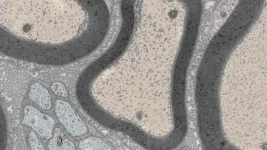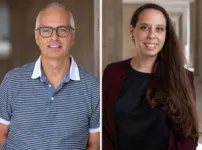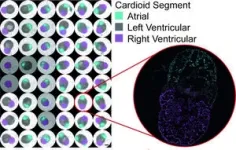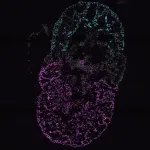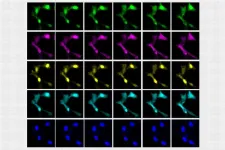(Press-News.org) LA JOLLA (November 28, 2023)—Each year in the United States there are more than 3 million cases of peripheral neuropathy, wherein nerves outside of the brain and spinal cord are damaged and cause pain and loss of feeling in the affected areas. Peripheral neuropathy can occur from diabetes, injury, genetically inherited disease, infection, and more. Salk scientists have now uncovered in mice a mechanism for repairing damaged nerves during peripheral neuropathy. They discovered that the protein Mitf helps turn on the repair function of specialized nervous system Schwann cells.
The findings, published in Cell Reports on November 28, 2023, have the potential to inspire novel therapeutics that bolster repair function and heal peripheral neuropathy.
“We wanted to know what mechanisms control damage response in peripheral nerves under varying conditions—like acute trauma, genetic disorders, or degenerative diseases,” says senior author Professor Samuel Pfaff. “We found that Schwann cells, which are special cells in nerves that protect and support neurons’ axons, enter their repair state because of a pathway mediated by the protein Mitf.”
The peripheral nervous system is made up of all the nerves that branch out from the brain and spinal cord to give us sensation throughout our bodies. There are many cell types in peripheral nerves, but Pfaff and his team focus on understanding neurons, which transmit information throughout the nervous system, and Schwann cells, which protect healthy neurons and repair damaged ones.
The peripheral nervous system’s ability to repair damage is remarkable considering that the central nervous system—made up of the brain and spinal cord—is not able to repair damage. Yet, the mechanisms that orchestrate this feat have remained poorly understood.
To unravel how Schwann cells differentiate to begin repairing peripheral nerve damage, the researchers looked at mouse models of Charcot Marie Tooth disease (CMT), a type of hereditary neuropathy.
"Going into this project, I thought that when you have a genetic nerve degeneration disorder, cells are dying and recovery isn’t possible,” says first author Lydia Daboussi, a former postdoctoral researcher in Pfaff’s lab and current assistant professor at UC Los Angeles. “But our findings show that there are gene programs turned on by Mitf that repair some of the damage done in those chronic disease scenarios, and when you turn those programs off, disease symptoms get worse.”
In mice with CMT, the researchers noticed that the Schwann cells completing the repairs had high levels of Mitf in their nuclei—where the genetic instructions for how to be a Schwann cell and how to conduct repairs are stored.
Upon investigation of this relationship between Mitf and Schwann cells, they found that Mitf was in the cytoplasm of Schwann cells until sensing neuronal damage. Damage then prompted Mitf to relocate from the cytoplasm of the cell to the nucleus, where it would direct the Schwann cell to make repairs.
To validate the importance of Mitf in creating repair Schwann cells, the researchers removed Mitf altogether. In cases of both trauma and CMT, nerve repair was arrested in the absence of Mitf—demonstrating that Mitf is required for peripheral nerve repair and regeneration.
According to Daboussi, Mitf acts like a fire extinguisher. Always there, sitting in the Schwann cell, unnoticed until damage occurs. And when that damage occurs, Mitf is ready to go and immediately turns on the cell’s repair functions.
Most surprising, noted Pfaff, was that Mitf was orchestrating these repairs during a chronic disease like CMT.
“Harnessing Schwann cell repair programs has great potential in treating chronic diseases,” says Pfaff, also the Benjamin H. Lewis Chair at Salk. “It’s possible that with targeted therapeutics, we can prompt more Schwann cells to repair peripheral nerve damage and push those repairs to completion in chronic cases. Furthermore, now that we have a better grasp on the repair mechanisms, we can see if it’s possible to initiate repairs in the brain stem and spinal cord, too.”
In the future, the researchers want to look more specifically at diabetes neuropathy—the most common peripheral neuropathy condition. They also hope to explore therapeutics that bolster this repair pathway to create more Schwann cells programmed to repair damage, regardless of if the source is trauma, genetics, or development over time.
Other authors include Giancarlo Costaguta, Miriam Gullo, Nicole Jasinski, Veronica Pessino, Brendan O’Leary, Karen Lettieri, and Shawn Driscoll of Salk.
The work was supported by the Sol Goldman Charitable Trust, Howard Hughes Medical Institute, National Institutes of Health (grants NCI CCSG: P30 014195, NCI CCSG: P30 014195, S10 OD023427, S10 OD026929, 1 RO1 NS123160-01), a George E. Hewitt Fellowship, a Salk Women & Science Fellowship, and a Jonas Salk Fellowship.
About the Salk Institute for Biological Studies:
Unlocking the secrets of life itself is the driving force behind the Salk Institute. Our team of world-class, award-winning scientists pushes the boundaries of knowledge in areas such as neuroscience, cancer research, aging, immunobiology, plant biology, computational biology, and more. Founded by Jonas Salk, developer of the first safe and effective polio vaccine, the Institute is an independent, nonprofit research organization and architectural landmark: small by choice, intimate by nature, and fearless in the face of any challenge. Learn more at www.salk.edu.
END
Repairing nerve cells after injury and in chronic disease
Salk researchers discover protein Mitf mediates the repair function in the peripheral nervous systems of mice, offering potential new therapeutic target
2023-11-28
ELSE PRESS RELEASES FROM THIS DATE:
First multi-chamber heart organoids unravel human heart development and disease
2023-11-28
Heart disease kills 18 million people each year, but the development of new therapies faces a bottleneck: no physiological model of the entire human heart exists – so far. A new multi-chamber organoid that mirrors the heart’s intricate structure enables scientists to advance screening platforms for drug development, toxicology studies, and understanding heart development. The new findings, using heart organoid models developed by Sasha Mendjan’s group at the Institute of Molecular ...
Race and ethnicity and emergency department discharge against medical advice
2023-11-28
About The Study: The findings of this study of 33.1 million visits to 989 U.S. hospitals suggest that Black and Hispanic patients are more likely to receive care in hospitals with higher overall discharge against medical advice (DAMA) rates, suggesting interventions should address medical segregation. Structural racism may contribute to emergency department DAMA disparities via unequal allocation of health care resources in hospitals that disproportionately treat racial and ethnic minoritized groups. Monitoring variation in DAMA by race and ethnicity and hospital suggests ...
Strategies to increase cervical cancer screening with mailed HPV self-sampling kits
2023-11-28
About The Study: Direct-mail human papillomavirus (HPV) self-sampling increased cervical cancer screening by more than 14% in individuals who were due or overdue for cervical cancer screening in this randomized clinical trial of 31,000 individuals. The opt-in approach minimally increased screening. To increase screening adherence, systems implementing HPV self-sampling should prioritize direct-mail outreach for individuals who are due or overdue for screening. For individuals with unknown screening history, ...
Scientists track rapid retreat of Antarctic glacier
2023-11-28
Scientists are warning that apparently stable glaciers in the Antarctic can “switch very rapidly” and lose large quantities of ice as a result of warmer oceans.
Their finding comes after a research team led by Benjamin Wallis, a glaciologist at the University of Leeds, used satellites to track the Cadman Glacier, which drains into Beascochea Bay, on the west Antarctic peninsula.
Between November 2018 and May 2021, the glacier retreated eight kilometres as the ice shelf at the end ...
A new way to see the activity inside a living cell
2023-11-28
CAMBRIDGE, MA -- Living cells are bombarded with many kinds of incoming molecular signal that influence their behavior. Being able to measure those signals and how cells respond to them through downstream molecular signaling networks could help scientists learn much more about how cells work, including what happens as they age or become diseased.
Right now, this kind of comprehensive study is not possible because current techniques for imaging cells are limited to just a handful of different molecule types within a cell at one time. However, MIT researchers have developed ...
Prioritizing circulation before the airway in trauma may improve outcomes for patients with massive bleeding
2023-11-28
Key takeaways
· A paradigm shift in trauma care: The circulation-airway-breathing (CAB) sequence has gained acceptance over the past decade over the airway-breathing-circulation (ABC) model for patients with severe bleeding injuries.
· Better outcomes: A literature review found significantly lower mortality rates with CAB vs. ABC for patients with severe bleeding injuries.
CHICAGO (November 28, 2023): For trauma patients suffering from massive blood loss, a care approach that emphasizes halting bleeding and restoring ...
Australian patients coping with mesothelioma experienced higher levels of toxicity on CheckMate743 regimen than reported in clinical trials
2023-11-28
Based on results from the CheckMate743 trial, the dual regimen of ipilimumab and nivolumab is the standard of care for the treatment of unresectable pleural mesothelioma. But research published today in the Journal of Thoracic Oncology (JTO) showed that a group of Australian patients treated with that immunotherapy combination experienced higher levels of toxicity than were reported in the clinical trial results. The study is available here: https://www.jto.org/article/S1556-0864(23)02370-5/fulltext.
JTO is the official journal of the International Association for the Study of Lung Cancer.
Australia ...
More to learn about reducing the churn: Examining the pandemic’s continuous enrollment Medicare policy
2023-11-28
Boston, MA – A new study led by researchers at the Harvard Pilgrim Health Care Institute has found that a federal policy implemented during the COVID-19 pandemic requiring continuous enrollment in Medicaid led to a significant reduction in the rates of becoming uninsured for adult Medicaid enrollees.
The study, “Continuous Medicaid coverage during the COVID-19 public health emergency reduced churning, but did not eliminate it,” was published in the October 21 edition of Health Affairs Scholar.
Many people who have Medicaid coverage frequently gain and lose it, sometimes over short periods of time. This phenomenon ...
No significant link between industry 4.0 and energy consumption or energy intensity
2023-11-28
To what extent does the digitalisation of industrial and manufacturing processes (Industry 4.0) improve energy efficiency and thus reduce energy intensity? A team from the Research Institute for Sustainability (RIFS) analysed developments across ten industrial manufacturing sectors in China between 2006 and 2019. Their findings show that contrary to the claims of many policymakers and industry associations, digitalisation may not automatically lead to anticipated energy savings in manufacturing and industry in China.
China accounts for 30% of global manufacturing value added and the largest share of global manufacturing ...
Weill Cornell Medicine to open medical research center at 1334 York Avenue
2023-11-28
Weill Cornell Medicine is dramatically expanding its campus and research footprint in New York City by securing five floors of 1334 York Ave., the current home of Sotheby's auction house, the institution announced today.
Located one block from Weill Cornell Medicine’s main campus on Manhattan’s Upper East Side, the site will add approximately 200,000 square feet of dedicated research space—an average of 40,000 square feet per floor—making it the institution’s largest expansion since the Belfer Research Building opened in 2014. Laboratories in the new medical ...
LAST 30 PRESS RELEASES:
Scientists boost cell "powerhouses" to burn more calories
Automatic label checking: The missing step in making reliable medical AI
Low daily alcohol intake linked to 50% heightened mouth cancer risk in India
American Meteorological Society announces Rick Spinrad as 2026 President-Elect
Biomass-based carbon capture spotlighted in newly released global climate webinar recording
Illuminating invisible nano pollutants: advanced bioimaging tracks the full journey of emerging nanoscale contaminants in living systems
How does age affect recovery from spinal cord injury?
Novel AI tool offers prognosis for patients with head and neck cancer
Fathers’ microplastic exposure tied to their children’s metabolic problems
Research validates laboratory model for studying high-grade serous ovarian cancer
SIR 2026 delivers transformative breakthroughs in minimally invasive medicine to improve patient care
Stem Cell Reports most downloaded papers of 2025 highlight the breadth and impact of stem cell research
Oxford-led study estimates NHS spends around 3% of its primary and secondary care budget on the health impacts of heat and cold in England
A researcher’s long quest leads to a smart composite breakthrough
Urban wild bees act as “microbial sensors” of city health.
New study finds where you live affects recovery after a hip fracture
Forecasting the impact of fully automated vehicle adoption on US road traffic injuries
Alcohol-related hospitalizations from 2016 to 2022
Semaglutide and hospitalizations in patients with obesity and established cardiovascular disease
Researchers ‘listen in’ to embryo-mother interactions during implantation using a culture system replicating the womb lining
How changing your diet could help save the world
How to make AI truly scalable and reliable for real-time traffic assignment?
Beyond fragmented markets: A new framework for efficient and stable ride-pooling
Can shape priors make road perception more reliable for autonomous driving?
AI tracks nearly 100 years of aging research, revealing key trends and gaps
Innovative techniques enable Italy’s first imaging of individual trapped atoms
KIER successfully develops Korea-made “calibration thermoelectric module” for measuring thermoelectric device performance
Diversifying US Midwest farming for stability and resilience
Emphasizing immigrants’ deservingness shifts attitudes
Japanese eels, climate change, and river temperature
[Press-News.org] Repairing nerve cells after injury and in chronic diseaseSalk researchers discover protein Mitf mediates the repair function in the peripheral nervous systems of mice, offering potential new therapeutic target
